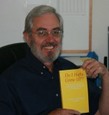If we were to diagram most adult relationships as stick figure art, we would have a confusion of interlocking lines. Even if different colors were used for each person, arms and leg lines would show a lot of confusion, struggle and oppositional positioning. That's because for the most part we continue to deal with adult love relations much as we did in our original families. And we have secondary lines of confusion with our children, larger families, close friends, and, of course, worst enemies.
Back when we were little, it was normal and necessary to have entanglements of our personal lines of energy because we didn't, and couldn't, tell the difference between where we began and the grown ups around us ended. That was natural, normal, and to a large extent, necessary. The fact that it's still going on in our adult lives, is not natural, normal, or necessary. In fact it is an aberration in the greater plan that propels us from single celled organisms to adult-sized humans.
We were supposed to get through the entanglements in which we couldn't tell the difference between us and our Mommies that gave her complete access to our inner wants and needs. As babes in our mother's arms we didn't care that following birth we have skin separating us. We felt totally connected. And so did our mommies. Trust, security, and an inner sense of enough come via this connection.
That connection was supposed to come to resolution during our “terrible two's” phase wherein we vacillated between opposition to our most important caretaker and compliance with her wishes, as if we continued being connected. Our dependence on others for managing our bodily functions, eating habits, emotional lives and thinking is designed to be resolved before the end of this phase so that we go forth as autonomous little humans. The entanglements we had in our families were intended to resolve, so that our lines had fewer and fewer interconnections until we entered adulthood as whole, complete persons.
When we exit the oppositional stage with a high degree of completion, we find that later struggles with attaining some level of personal power, boundaries and a solid sense of identity are winnable. Relationships diagram quite differently for those who have made it into adulthood as true grown ups. They look like two complete figures, with capability to move around on their own, manage their lives without outside help, and relate without neediness or imagined interconnection. That doesn't mean there aren't lines of energy passing between them. In fact the capacity for exchange increases in proportion of the level of how complete each person has become. And the exchange is mutual, based on agreements, not how needy one or both parties are.
Problem is that fewer than 15% of our population actually made it to the threshold of grownupness in which we claim the latent capacity we all have to become complete humans. Instead of getting on with the business that brought us to these bodies and our life at hand, we continue to work on getting there. That's because the internal drive to complete the process never goes away. Most of it goes on at a subliminal level that we are taught not to notice, so we fail to recognize just how familiar are our current relationship problems.
We demand that our loved ones be trustable if we didn't resolve that issue early on. Insecurity and a persistent need to fill some deep void of emptiness become a primary focal point of our primary connections. Failing that we connect with food, pets, collectibles, and fantasy (television and movies). In stick art these interconnections make our figures a complex tangle of lines, agonizingly difficult to unknot. Which makes the original task of becoming a complete person only that much more difficult, albeit even more compelling because with every entanglement and disentanglement we find it increasingly complex. Our original incompleteness becomes increasingly layered over with subsequent entanglements that fail to resolve their original purpose—to complete us.
Which is not to say the problem is a hopeless Gordian Knot, incapable of solution. However we need to recognize that our understanding of the problem needs clarification. Most of the solutions to particular entanglements fail to resolve the problem because looking for solution from external sources will never work. Marital counselors can arbitrate and help to manage symptoms of our entanglements, but most professionals are no further along developmentally than we are, so their management approaches are capable of mitigating but not healing the underlying dynamic.
To resolve our entanglements we need to have professionals with their own foundational elements fully developed and intact, equipped with a model that understands where entanglement issues originate. We have a multitude of models answering the question “what's wrong” while lacking a concept of what constitutes a healthy, grown up human being. Actually, the process for becoming grownups is inherent in our own childhood—but it has been vigorously reinterpreted by a church intent upon being in the path to source, social institutions intent on having useful citizens, and parenting traditions warped to particular values.
It is only when we understand and follow the path laid out for us as our youthful challenges that we find the facility to become complete individuals with real power, who know ourselves and why we came to this life.
Much more on this and related topics can be found at http://doihaftagrowup.com. You can take a test of just how well you mastered connection and subsequent foundational challenges and read related articles.
Gary Robertson is author of DO I HAFTA GROW UP, THE ADULT GUIDE TO UNFINISHED BUSINESS OF CHILDHOOD. As director of Springs Foundation, a non-profit organization, he designed a program called Growing Bones that allows clients to reclaim missing elements of their developmental foundation and become truly grown up. Springs Foundation offers healing methods based in Energy Psychology and Energy Medicine. Visit HTTP://springsfoundation.org for more information.

Post new comment
Please Register or Login to post new comment.